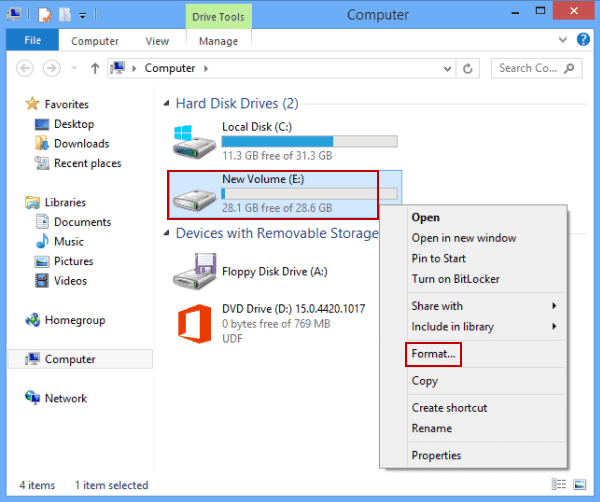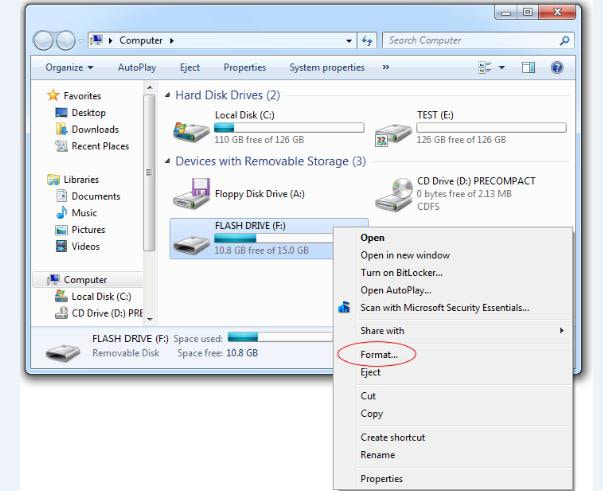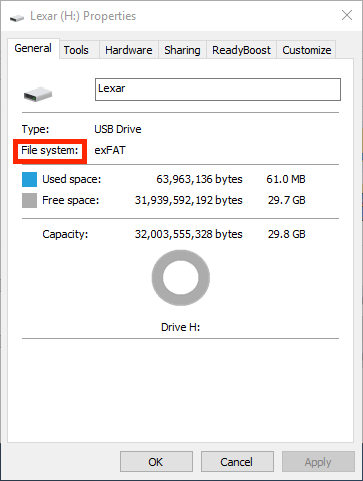Just like most storage mediums, partitioning a flash drive is also possible. There may be a number of reasons why you would want to partition a flash drive. If you have never partitioned a flash drive before, then don't worry; this article will help you. Read on to find how to partition a flash drive..
- Windows 10 Format Usb Drive
- Format Flash Drive For Mac And Windows 10 64-bit
- Best Flash Drives For Macs
- Flash Drive For Mac And Pc
- Format Flash Drive Windows 10
Partition with Diskpart
Partition with an USB Flash Drive Partition Tool
Bonus Tip 1. Best Way to Recover Files from Flash Drive after Partition or Format
1How to Partition Flash Drive on Windows10/8.1/8/7?
Insert the flash drive or hard drive you want to format for Windows compatibility. Go to the Applications folder on your Mac’s hard drive, then go to the Utilities folder, and launch Disk Utility. Select the drive you want to format. Warning: the following steps will delete any info you currently have on the drive. Here are three proven methods on how to format USB flash drive to NTFS. Format USB Flash drive to NTFS using Disk Management. Find My Computer in the Start menu or by typing it in the search bar. Right-click on it and click on Manage. In Device Manager, look for your USB drive in the Disk Drives tab.
Although it is possible to create multiple partitions on a flash drive via third-party tools, Windows will only read and show the first/primary partition. If you want the Windows to read a certain partition of the flash drive, then you will need a third-party tool to set that partition as primary.
Backup Your Data
Partitioning a flash drive will erase all data stored on it. That's why it is highly recommended that you back up all the important data before proceeding. The backup process is quite easy as all you need to do is connect the flash drive to your computer and copy the desired data to a location of your choice. Follow these instructions:
1. Connect your flash drive to your computer. Then open This PC on your Windows and find your flash drive.
2. Double-click on it to see its contents. Select the files that you want to back up and right-click on them and click Copy.
3. After that, navigate to the folder on your computer's hard drive where you want to store those files, right-click and select the Paste option. The transfer process will begin and your selected files will be copied to that folder.
Now that you have backed up your data, you can proceed to partition your flash drive. Following are some methods to do this:
1Partition a Flash Drive Using Diskpart
You can easily partition a flash drive via the Diskpart utility of Windows. The utility is run through Command Prompt. Follow these instructions:
Step 1. Press Windows and R key on your keyboard at the same time and type 'diskpart' in the Run pop-up window and then press Enter to launch it. A command prompt window will open.
Step 2. On that window, input 'list disk' to see which number your connected flash drive has.
Step 3. Next, input 'select disk X (X here is the number for your flash drive). It will be selected.

Step 4. Now input 'clean' and press enter to clean the device.
Step 5. Now enter 'list part' and then input 'create partition primary'. After that, input 'list part' and then input 'select partition 1'. Set this partition as active by inputting 'active'.
Step 6. Next, input 'format fs=fat32' to format the partition. After that, your newly created flash drive partition will be ready to use.
2Partition a Flash Drive with an USB Flash Drive Partition Tool
If the method to partition a flash drive via diskpart seems complicated, then there is another easier way to partition a flash drive. You can partition the USB flash drive via a flash drive partition tool called Bootit. Follow these instructions to partition a flash drive via Bootit:
Fist, you should install and launch Bootit software on your computer.
Step 1. Connect your flash drive to your computer and make sure it is detected by the operating system.
Step 2. Now open Disk Management on your computer. You can launch it from the Start Menu.
Step 3. Now select the current partition shown on the flash drive and delete it via the software.
Step 4. After that, right-click on the unallocated space of flash drive and click on New Simple Volume to create a partition. You can specify the size, label, etc. for the new partition according to your preferences.
Step 5. You can create multiple partitions on your flash drive by repeating the above step.
2How to Partition a Flash Drive on Mac?
If you want to partition your flash drive on your Mac, then you will be glad to know that it is possible. On Mac, you can do this via Disk Utility.
Steps to Partition Flash Drive on Mac
Follow these instructions to partition flash drive on Mac:
Step 1. On your Mac, open Disk Utility. And connect your flash drive to your Mac.
Step 2. Once the Disk Utility is opened, select your flash drive from the sidebar and click the Erase button.
Step 3. On the newly opened window, select OS X Extended (Journaled) from the Format menu.

Step 4. Make sure to click on Scheme > GUID Partition Map. Next, format the drive via the Erase option.
Step 5. After formatting, click the Partition button and then use the '+' button to create and add additional partitions. Add as many partitions as you like.
Step 6. After setting the sizes, labels, etc. to partitions, click Apply to confirm your action. Partitions will be created.
Bonus Tip 1. Best Way to Recover Files from Flash Drive after Partition or Format
It's wise to backup the data on your flash drive before partitioning or formatting it. So, what to do if you forgot this or some important files were left when made a backup? Don't worry, a powerful data recovery tool can help you find them back!
iMyFone AnyRecover is one of such popular data recovery tools. It can help you find all your lost files no matter how you lost them. Files recovery at a formatted or partitioned USB flash drive is easy as 1-2-3 with AnyRecover.
Key FeaturesRecover lost files from different data loss scenarios, including formatted data recovery, deleted files recovery, formatted device recovery, etc.
Recover over 1000 type of files, including photos, videos, audios, emails, documents, archives and more.
Recover files from various storage mediums, such as USB flash drive, hard drive, SD card, digital camera, computer, etc.
Differing from other recovery tools, AnyRecover is 100% safe to use, it won't do any damage to your existing data.
One of the most reliable data recovery software with high data recovery rate - Up to 98%.
Steps to Recover Files from Flash Drive after Partition or Format
Step 1. Open AnyRecover on your computer, then connect your Flash Drive to your computer, select it.
Step 2. After selecting the location, hit “Start” button to start the process.
Step 3. After scanning, preview and select the files, then click on Recover button to get the lost files back.
Bonus Tip 2. Best USB Flash Drive for Windows & Mac
Among many quality flash drives, SanDisk Extreme PRO 128 GB Drive is considered the most popular USB flash drive for Windows and Mac. Following are the top features of this USB flash drive:
Blistering speeds: 380 MB/s write, 420 MB/s read.
Durable, sleek, and eye-catching aluminum casing design.
AES, 128-bit file encryption for excellent security for sensitive files.
USB 3.0 as well as backward compatibility with USB 2.0.
Lifetime warranty.
What you need to install Windows 10 on Mac
- MacBook introduced in 2015 or later
- MacBook Air introduced in 2012 or later
- MacBook Pro introduced in 2012 or later
- Mac mini introduced in 2012 or later
- iMac introduced in 2012 or later1
- iMac Pro (all models)
- Mac Pro introduced in 2013 or later
The latest macOS updates, which can include updates to Boot Camp Assistant. You will use Boot Camp Assistant to install Windows 10.
64GB or more free storage space on your Mac startup disk:
- Your Mac can have as little as 64GB of free storage space, but at least 128GB of free storage space provides the best experience. Automatic Windows updates require that much space or more.
- If you have an iMac Pro or Mac Pro with 128GB of memory (RAM) or more, your startup disk needs at least as much free storage space as your Mac has memory.2
An external USB flash drive with a storage capacity of 16GB or more, unless you're using a Mac that doesn't need a flash drive to install Windows.
A 64-bit version of Windows 10 Home or Windows 10 Pro on a disk image (ISO) or other installation media. If installing Windows on your Mac for the first time, this must be a full version of Windows, not an upgrade.
Windows 10 Format Usb Drive
- If your copy of Windows came on a USB flash drive, or you have a Windows product key and no installation disc, download a Windows 10 disk image from Microsoft.
- If your copy of Windows came on a DVD, you might need to create a disk image of that DVD.
How to install Windows 10 on Mac

To install Windows, use Boot Camp Assistant, which is included with your Mac.
1. Check your Secure Boot setting
Learn how to check your Secure Boot setting. The default Secure Boot setting is Full Security. If you changed it to No Security, change it back to Full Security before installing Windows. After installing Windows, you can use any Secure Boot setting without affecting your ability to start up from Windows.
2. Use Boot Camp Assistant to create a Windows partition
Open Boot Camp Assistant, which is in the Utilities folder of your Applications folder. Follow the onscreen instructions.
- If you're asked to insert a USB drive, plug your USB flash drive into your Mac. Boot Camp Assistant will use it to create a bootable USB drive for Windows installation.
- When Boot Camp Assistant asks you to set the size of the Windows partition, remember the minimum storage-space requirements in the previous section. Set a partition size that meets your needs, because you can't change its size later.
3. Format the Windows (BOOTCAMP) partition
When Boot Camp Assistant finishes, your Mac restarts to the Windows installer. If the installer asks where to install Windows, select the BOOTCAMP partition and click Format. In most cases, the installer selects and formats the BOOTCAMP partition automatically.
4. Install Windows
Unplug any external devices that aren't necessary during installation. Then click Next and follow the onscreen instructions to begin installing Windows.
5. Use the Boot Camp installer in Windows
After Windows installation completes, your Mac starts up in Windows and opens a ”Welcome to the Boot Camp installer” window. Follow the onscreen instructions to install Boot Camp and Windows support software (drivers). You will be asked to restart when done.
- If the Boot Camp installer never opens, open the Boot Camp installer manually and use it to complete Boot Camp installation.
- If you have an external display connected to a Thunderbolt 3 port on your Mac, the display will be blank (black, gray, or blue) for up to 2 minutes during installation.
How to switch between Windows and macOS
Restart, then press and hold the Option (or Alt) ⌥ key during startup to switch between Windows and macOS.
Learn more
If you have one of these Intel-based Mac models using OS X El Capitan or later, you don't need a USB flash drive to install Windows:
Format Flash Drive For Mac And Windows 10 64-bit

- MacBook introduced in 2015 or later
- MacBook Air introduced in 2017 or later3
- MacBook Pro introduced in 2015 or later3
- iMac introduced in 2015 or later
- iMac Pro (all models)
- Mac Pro introduced in late 2013 or later
To remove Windows from your Mac, use Boot Camp Assistant, not any other utility.
Best Flash Drives For Macs
For more information about using Windows on your Mac, open Boot Camp Assistant and click the Open Boot Camp Help button.
Flash Drive For Mac And Pc
1. If you're using an iMac (Retina 5K, 27-inch, Late 2014) or iMac (27-inch, Late 2013) or iMac (27-inch, Late 2012) with a 3TB hard drive and macOS Mojave or later, learn about an alert you might see during installation.
2. For example, if your Mac has 128GB of memory, its startup disk must have at least 128GB of storage space available for Windows. To see how much memory your Mac has, choose Apple menu > About This Mac. To see how much storage space is available, click the Storage tab in the same window.
Format Flash Drive Windows 10
3. These Mac models were offered with 128GB hard drives as an option. Apple recommends 256GB or larger hard drives so that you can create a Boot Camp partition of at least 128GB.
